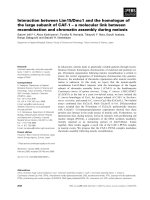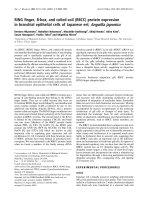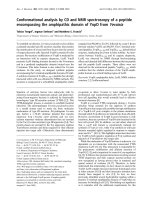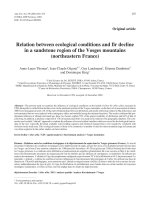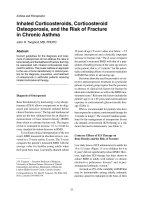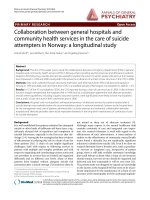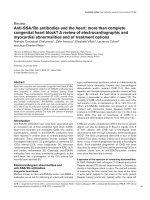Báo cáo y học: "Relation between lipogranuloma formation and fibrosis, and the origin of brown pigments in lipogranuloma of the canine liver" ppsx
Bạn đang xem bản rút gọn của tài liệu. Xem và tải ngay bản đầy đủ của tài liệu tại đây (532.59 KB, 6 trang )
BioMed Central
Page 1 of 6
(page number not for citation purposes)
Comparative Hepatology
Open Access
Research
Relation between lipogranuloma formation and fibrosis, and the
origin of brown pigments in lipogranuloma of the canine liver
Kaori Isobe*, Hiroyuki Nakayama and Koji Uetsuka
Address: Department of Veterinary Pathology, Graduate School of Agricultural and Life Sciences, University of Tokyo, Japan
Email: Kaori Isobe* - ; Hiroyuki Nakayama - ;
Koji Uetsuka -
* Corresponding author
Abstract
Background: In a previous study we confirmed that canine hepatic lipogranuloma, defined as
lesions consisting of small round cells which contain lipid vacuoles and brown pigments in their
cytoplasm, was an assembly of Kupffer cells and/or macrophages, and that the cytoplasmic brown
pigments in the lesions were hemosiderin and ceroid. However, the pathogenesis of the lesion
remains unclear. Kupffer cells (resident macrophages) play a key role in hepatic fibrogenesis due to
the production of cytokines including TGF-β. In the present study, we have examined 52 canine
liver samples (age: newborn – 14 years; 25 males and 27 females) and investigated the correlation
between lipogranuloma formation and fibrosis as well as the origin of brown pigments of
lipogranulomas.
Results: Lipogranulomas were detected histopathologically in 23 (44.2%) of the 52 liver samples.
No significant correlation was found between the density of lipogranulomas and distribution of
collagen type I/III in the liver. Pigmentation of lipogranulomas showed significant correlations with
that on both hepatocytes and sinusoidal cells, indicating that pigments of lipogranuloma
(hemosiderin and ceroid) might be derived from hepatocytes and Kupffer cells.
Conclusion: Lipogranulomas are not a contributing factor in hepatic fibrosis, but might be a
potential indicator of the accumulation of iron and lipid inside the liver.
Background
Lipogranulomas, also termed fatty cysts, are often found
in the hepatic parenchyma of dogs [1,2], especially of
those with portosystemic shunt (PSS) [3-6], and are
defined as lesions consisting of small round cells which
contain lipid vacuoles and brown pigments in their cyto-
plasm, although the amounts of vacuoles and pigments
vary among lesions. Besides the canine liver, lipogranulo-
mas are observed in the rat as well as in human livers with
cirrhosis [7-10], and are considered to be involved in
hepatic cirrhosis in human medicine [9,10]. However, in
canine cases, the significance of lipogranulomas in the
pathogenesis of cirrhosis is still not clear.
Our previous study [11] confirmed that hepatic lipogran-
uloma consisted of Kupffer cells and/or macrophages, and
the cytoplasmic brown pigments were hemosiderin and
ceroid, although the pathogenesis of canine lipogranu-
loma remains unclear. Kupffer cells (resident macro-
phages) play a key role in hepatic fibrogenesis due to the
production of cytokines including transforming growth
factor-β (TGF-β) [12-14]. TGF-β, one of the most pro-
Published: 12 May 2008
Comparative Hepatology 2008, 7:5 doi:10.1186/1476-5926-7-5
Received: 20 February 2008
Accepted: 12 May 2008
This article is available from: />© 2008 Isobe et al; licensee BioMed Central Ltd.
This is an Open Access article distributed under the terms of the Creative Commons Attribution License ( />),
which permits unrestricted use, distribution, and reproduction in any medium, provided the original work is properly cited.
Comparative Hepatology 2008, 7:5 />Page 2 of 6
(page number not for citation purposes)
fibrotic cytokines, is necessary and sufficient for the
induction and progression of fibrotic lesions, and may
serve as the initiating event in the activation of myofi-
broblasts, which then secrete a large amount of extracellu-
lar matrix [15]. We therefore supposed that the
component cells of lipogranulomas might have the
potential to cause hepatic fibrosis.
Moreover, it is uncertain from where the pigments of
canine lipogranuloma are derived. Although it is already
demonstrated that hepatocytes are not directly involved in
lipogranuloma formation [11], it might be possible that
hepatocytes containing pigments are phagocytized by
Kupffer cells, which then form a lipogranuloma.
In the present study, we histopathologically examined the
correlation between lipogranulomas and fibrosis, and
speculated the origin of brown pigments of lipogranulo-
mas.
Results
Histopathology of the liver
Histopathological diagnoses of the 52 canine autopsy
cases examined in the present study are shown in Table 1.
Histopathological changes in the liver were observed in
most cases. In cases 8, 19, 28, 34, 36 and 38, tumor metas-
tases to the liver were observed. In case 18, thrombi were
formed in large vessels in the portal area. In case 52, nod-
ular proliferation of well-differentiated hepatocarcinoma
was focally observed. In case 41, cholangiocarcinoma pro-
liferated densely with a tubuliform pattern.
Incidence and density of lipogranulomas
Among 52 autopsy cases, lipogranulomas were found in
the livers of 23 cases (44.2%) (Table 1). The density of
lipogranulomas was classified into scores 0 to 3: score 0:
29 cases (55.8%); score 1: 14 cases (27.0%); score 2: 6
cases (11.5%); and score 3: 3 cases (5.8%) of total 52
canine cases. The mean score was 1.5 ± 0.7 (mean ± S.D.).
Fibrosis score
Fibrosis was graded with scores 0 to 3 (Table 2) according
to the amount and distribution of collagen. The mean
scores for fibrosis were: collagen type I; 1.6 ± 1.1, and type
III; 2.3 ± 0.6. Neither score was statistically related to that
of lipogranuloma density.
Pigmentation score
Lipogranuloma is defined as an aggregation of cells con-
taining lipid vacuoles and brown pigments in the cyto-
plasm, as mentioned above. The pigments were positively
stained with Berlin blue and Schmorl (Fig. 1a,d). Such
pigments were seen also in the cytoplasm of some hepa-
tocytes (Fig. 1b,e) and sinusoidal cells (Fig. 1c,f). The
scores of pigmentation are summarized in Table 3, indi-
cating 2.2 ± 1.1 (Berlin blue) and 2.2 ± 0.7 (Schmorl) of
lipogranuloma, 1.3 ± 0.9 (Berlin blue) and 2.2 ± 0.6
(Schmorl) of hepatocytes, and 2.3 ± 1.1 (Berlin blue) and
2.1 ± 0.8 (Schmorl) of sinusoidal cells. Regarding the
amount of Berlin blue-positive iron pigments in lipogran-
ulomas, hepatocytes and sinusoidal cells, positive correla-
tions were mutually found among them (P < 0.05) (Table
3). Schmorl-positive ceroid pigmentation in lipogranulo-
mas was positively correlated both with that on hepato-
cytes and sinusoidal cells from the results of Schmorl (P <
0.05), although no correlation was observed between pig-
mentation in hepatocytes and sinusoidal cells (Table 3).
Discussion
Hepatic lipogranulomas are defined as lesions consisting
of small round cells which contain lipid vacuoles and
brown pigments in their cytoplasm, although the
amounts of vacuoles and pigments vary among lesions.
Our previous study [11] confirmed that the lesions con-
sisted of Kupffer cells and/or macrophages, and the cyto-
plasmic brown pigments are hemosiderin and ceroid.
Macrophages play a very prominent role in fibrotic dis-
eases [15]. Resident and/or infiltrating macrophages play
a critical part in initiation of myofibroblast conversion
from precursor fibroblasts, fat-storing cells (Ito cells), and
endothelial cells [15]. Among them, Kupffer cells (resi-
dent macrophages) play a key role in fibrogenesis due to
the production of transforming growth factor-β (TGF-β)
[12-14], hepatocyte growth factor (HGF) [16], tumor-
necrosis factor-α (TNF-α) and nitric oxide, which in turn
activate fat-storing cells [17-19].
As no significant correlation was found between the den-
sity of lipogranulomas and distribution of collagen fibres,
lipogranuloma may not be directly involved in fibrogene-
sis of the liver. Since hepatic fibrosis is a complex process
that involves many hepatic cells other than Kupffer cells
and/or macrophages, it might be possible that the phago-
cytes could just trigger initiation of fibrotic events, but
could not amplify the fibrotic response which is necessary
for hepatic fibrosis.
The abnormal metabolism of iron and lipid may cause the
accumulation of hemosiderin and ceroid, respectively.
Accumulation of hemosiderin may indicate an increase of
red blood cell turnover, and that of ceroid may be a result
of increased hepatocyte turnover [2]. Iron and ceroid
accumulation is involved in increased oxidative stress
with iron-catalyzed production of reactive oxygen species
causing oxidative damage to lipids, proteins, and other
molecules [20,21]. This mechanism may bring about the
accumulation of iron and ceroid in hepatocytes, which are
then phagocytized by Kupffer cells or macrophages, and
subsequently a closely-aggregated "lipogranulomas" are
Comparative Hepatology 2008, 7:5 />Page 3 of 6
(page number not for citation purposes)
formed (Fig. 2). In canine PSS cases, on the other hand,
increased iron absorption at the duodenum [22] and
increased accumulation of ceroid caused by abnormal
lipid metabolism in the hepatocytes, might be key factors
in forming lipogranulomas (Fig. 2). Since hemosiderin
and ceroid are end metabolic products of iron and lipid,
respectively, the pigments remain in phagocytes once they
are phagocytized [21,23].
Table 1: Canine autopsy cases examined.
Case No. Sex
a)
Age
b)
Breed Lipogranulomas Main diagnosis
1 M 0 y Labrador Retriever - Systemic hyperemia/congestion
2 M 0 y Labrador Retriever - Systemic hyperemia/congestion
3 F 7 m Mongrel + Renal dysplasia
4 Mc 3 y 1 m Chihuahua - Necrotizing meningoencephalitis
5 F 3 y 5 m Shetland Sheepdog - Thymoma, Septicemia
6 M 3 y 10 m Shibainu - Severe enteritis, Nephritis
7 F 4 y Miniature Dachshund - Malignant lymphoma
8 M 4 y Bernese Mountain Dog - Malignant lymphoma
9 Mc 4 y 4 m American Cocker Spaniel - Meningoencephalitis
10 Fs 4 y 5 m Maltese + Necrotizing meningoencephalitis
11 M 4 y 6 m Miniature Dachshund - Thrombocytopenia
12 Fs 5 y 2 m Miniature Schnauzer - Chronic interstitial nephritis
13 Mc 5 y 4 m Miniature Dachshund - Gastroduodenitis
14 F 6 y Miniature Dachshund + Malignant melanoma
15 F 6 y 2 m Shih Tzu - hepatic and renal calcinosis
16 Mc 6 y 3 m Akitainu - Peritonitis, Septicemia
17 F 7 y Labrador Retriever + Chronic myelocytic leukemia
18 M 7 y 4 m English Cocker Spaniel + Thrombosis
19 Mc 7 y 4 m Golden Retriever - Malignant lymphoma
20 F 7 y 9 m Shetland Sheepdog - Chronic bronchopneumonia
21 F 8 y 1 m Shih Tzu - Enteritis, Interstitial nephritis
22 F 8 y 3 m Pug + Necrotizing meningoencephalitis
23 M 8 y 9 m Yorkshire Terrier + Catarrhal pneumonia
24 Fs 9 y Golden Retriever - Mammary carcinoma
25 M 9 y Miniature Pinscher + Malignant mesothelioma
26 M 9 y 3 m Labrador Retriever + Malignant lymphoma
27 M 9 y 6 m Miniature Schnauzer + Hemangiosarcoma
28 M 9 y 7 m Whippet - Malignant histiocytoma
29 F 9 y 9 m Golden Retriever + Malignant mesothelioma
30 M 9 y 9 m Golden Retriever - Encephalatrophy
31 M 9 y 9 m Welsh Corgi Pembroke - Pulmonary calcinosis
32 M 10 y German Shepherd Dog - Infarction of heart, kidney, lung
33 F 10 y 4 m Shih Tzu - Intestinal hemorrhage
34 F 10 y 7 m Welsh Corgi Pembroke - Malignant lymphoma
35 Mc 10 y 11 m Labrador Retriever + Acute leukemia
36 Fs 11 y Mongrel - Fibrosarcoma
37 F 11 y 3 m Shih Tzu - Acute lymphocytic leukemia
38 F 11 y 3 m Labrador Retriever + Mammary carcinoma
39 M 11 y 5 m Beagle - Malignant lymphoma
40 M 11 y 5 m Shetland Sheepdog - Malignant histiocytoma
41 Fs 11 y 5 m Cavalier King Charles Spaniel - Uremic pneumonia
42 F 11 y 10 m Miniature Dachshund + Cholangiosarcoma
43 Mc 12 y Golden Retriever + Hemangiosarcoma
44 F 12 y 5 m Shih Tzu - Chronic interstitial nephritis
45 Fs 12 y 6 m Mongrel + Malignant lymphoma
46 F 13 y Miniature Dachshund + Fibrinopurulent pneumonia
47 Fs 13 y Mongrel + Transitinal carcinoma
48 F 13 y 9 m Long Coat Chihuahua + Chronic nephritis
49 F 13 y 9 m Miniature Dachshund + Malignant lymphoma
50 M 14 y Shih Tzu + Gastric perforation
51 Fs 14 y Labrador Retriever + Cardiac calcinosis, Thrombosis
52 Mc 14 y 3 m Italian Greyhound + Bronchial adenocarcinoma
a) M: male; Mc: male castrated; F: female; Fs: female spayed. b) y: years; m: months.
Comparative Hepatology 2008, 7:5 />Page 4 of 6
(page number not for citation purposes)
As demonstrated in our previous study [11], hepatocytes
are not mainly involved in the formation of lipogranulo-
mas. Here, we can propose two hypotheses regarding the
mechanism of lipogranuloma formation. One is that the
vacuolated hepatocytes with brown pigments (or iron/
lipid) in their cytoplasm are phagocytized by Kupffer
cells, and the other is that free pigments (or free iron/lipid
in blood) are directly phagocytized by Kupffer cells. Since
the pigmentation score of lipogranulomas showed posi-
tive correlation with that of both hepatocytes and sinusoi-
dal cells, both hypotheses were thought to be possible.
Given the above, we considered that the pigments of
lipogranulomas could be derived from both hepatocytes
and Kupffer cells. Moreover, lipogranulomas might be a
potential indicator of accumulation of iron and lipid
inside the liver.
Conclusion
There was no correlation between the density of lipogran-
ulomas and the distribution of fibrosis in the canine liver.
Pigmentation of hemosiderin and ceroid in lipogranulo-
mas had significant correlations with that in hepatocytes
and in sinusoidal cells, respectively, indicating that these
pigments in lipogranuloma might be derived from both
hepatocytes and Kupffer cells. It is concluded that
lipogranulomas are not a contributing factor for hepatic
fibrosis, but a potential indicator for the accumulation of
iron and lipid inside the liver.
Methods
Liver samples
The liver samples used in the present study were obtained
from 52 dogs autopsied between January 2005 and
December 2006 at the Department of Veterinary Pathol-
ogy, the University of Tokyo. The dogs comprised 25
males and 27 females ranging from newborn to 14 years
old (Table 1).
Histopathological methods
Excised liver tissues were fixed in 10% neutral-buffered
formalin, embedded in paraffin, and sectioned at 4 μm.
The paraffin sections were stained with hematoxylin and
eosin (HE). For further histopathological examination,
Berlin blue stain, Schmorl reaction, and immunostains
were performed.
For immunostain, deparaffinized sections were auto-
claved or digested in 1% trypsin for antigen retrieval, and
then immersed in 0.3% hydrogen peroxidase to block
internal peroxidase activity, and in 8% skimmed milk to
block non-specific binding of the primary antibody. The
primary antibodies used were: anti-rat collagen type I, rab-
bit serum (LSL CO., Cosmo Bio, Tokyo, Japan), diluted
1:400; and anti-mouse collagen type III, rabbit serum (LSL
CO., Cosmo Bio), diluted 1:200. The sections were then
reacted with each biotinylated secondary antibody (KPL,
Gaithersburg, MD, U.S.A.), incubated with peroxidase-
labeled streptavidin (Dako, Glostrup, Denmark), and vis-
ualized with 3,3'-diaminobenzidine-tetrahydrochloride
(DAB) as chromogen. Counterstaining was done with
methyl green.
Examination of liver sections
Fibrosis in the liver was evaluated using anti-rat collagen
type I and anti-mouse collagen type III antibodies. Pig-
mentation on lipogranulomas, hepatocytes and sinusoi-
dal cells was also evaluated using Berlin blue-stain or the
Schmorl reaction sections. Lipogranuloma density was
herein determined by counting the number of lipogranu-
lomas in 5 images (3,200 × 2,560 pixels), taken from each
HE section with a ×10 objective lens. The total number of
lipogranulomas in the 5 images was considered the
lipogranuloma density per a defined area unit. The den-
sity of lipogranulomas was classified into 4 scores, 0 to 3;
score 0: total number of lipogranulomas was zero; score 1:
below ten; score 2: below twenty; and score 3: twenty-one
and above.
Scoring criteria to determine the distribution of collagen
type I/III in the liver are shown in Table 2. Accumulation
Table 3: Estimated scores of pigmentation of lipogranulomas,
hepatocytes and sinusoidal cells.
Berlin blue Schmorl
Lipogranulomas 2.2 ± 1.1
a
2.2 ± 0.7
a
Hepatocytes 1.3 ± 0.9
b
2.1 ± 0.6
c
Sinusoidal cells 2.3 ± 1.1
c
2.1 ± 0.8
c
Score = Mean ± S.D. Within a column, values with different
superscript letters differ (P < 0.05).
Table 2: Scoring criteria for distribution of collagen type I/III, and pigmentation in the liver.
Score Distribution of collagen type I/III Pigmentation
0None None
1 Thin collagen fibers are occasionally observed in the foci of hepatocytic changes and/or periportal area Light
2 Distinct collagen fibers are observed in the foci of hepatocytic changes and/or periportal area Moderate
3 Thick and distinct collagen fibers are observed in the foci of hepatocytic changes and periportal area Severe
Comparative Hepatology 2008, 7:5 />Page 5 of 6
(page number not for citation purposes)
Pigmentation in lipogranulomas, hepatocytes and sinusoidal cellsFigure 1
Pigmentation in lipogranulomas, hepatocytes and sinusoidal cells. Brown pigments are positive for Berlin blue inside
lipogranulomas (a), hepatocytes (b) and sinusoidal cells (c), and for Schmorl in lipogranulomas (d), hepatocytes (e) and sinusoi-
dal cells (f). Bar = 20 μm.
Mechanism diagram of lipogranuloma formationFigure 2
Mechanism diagram of lipogranuloma formation.
Publish with Bio Med Central and every
scientist can read your work free of charge
"BioMed Central will be the most significant development for
disseminating the results of biomedical research in our lifetime."
Sir Paul Nurse, Cancer Research UK
Your research papers will be:
available free of charge to the entire biomedical community
peer reviewed and published immediately upon acceptance
cited in PubMed and archived on PubMed Central
yours — you keep the copyright
Submit your manuscript here:
/>BioMedcentral
Comparative Hepatology 2008, 7:5 />Page 6 of 6
(page number not for citation purposes)
of brown pigments was assessed by classifying the amount
of pigments in lipogranulomas, hepatocytes and sinusoi-
dal cells. The scoring criteria of pigmentation are also
shown in Table 2.
Statistical methods
Spearman rank correlation coefficients were used to test
the association between the density of lipogranuloma and
distribution of collagen type I/III, and to investigate the
origin of brown pigments of lipogranulomas [24]. P val-
ues less than 0.05 were considered to indicate significant
differences.
Competing interests
The authors declare that they have no competing interests.
Authors' contributions
KI performed most of the experiments and prepared the
manuscript. HN and KU provided assistance for the prep-
aration of the manuscript. KU participated in the design of
the study. All authors have read and approved the content
of the manuscript.
References
1. Kelly WR: The liver and biliary system. In Pathology of Domestic
Animals Volume 2. 4th edition. Edited by: Jubb KV, Kennedy PC, Palmer
N. San Diego: Academic Press; 1993:319-406.
2. Winkle TV, Collen JM, Ingh TSGAM van den, Charles JA, Desmet VJ:
Morphological classification of parenchymal disorders of the
canine and feline liver. In WSAVA Standards for Clinical and Histo-
logical Diagnosis of Canine and Feline Liver Disease 1st edition. WSAVA
Liver Standardization Group. Oxford: Elsevier Limited; 2006:103-116.
3. Baade S, Aupperle H, Grevel V, Schoon HA: Histopathological and
immunohistochemical investigations of hepatic lesions asso-
ciated with congenital portosystemic shunt in dogs. J Comp
Pathol 2006, 134:88-90.
4. Borrows CF: Liver disorders. In Clinical Medicine of the Dog and Cat
1st edition. Edited by: Schaer M. London: Veterinary Press;
2003:337-349.
5. Meyer DJ: Hepatic pathology. In Strombeck's Small Animal Gastro-
enterology 3rd edition. Edited by: Guilford WG, Center SA, Strombeck
DR, Williams DA, Meyer DJ. Philadelphia: W B Saunders;
1996:633-653.
6. Meyer DJ, Harvey JW: Hematologic changes associated with
serum and hepatic iron alterations in dogs with congenital
portosystemic vascular anomalies. J Vet Intern Med 1994,
8:55-56.
7. Christoffersen P, Braendstrup O, Juhl E, Poulsen H: Lipogranulo-
mas in human biopsies with fatty change. A morphological,
biochemical and clinical investigation. Acta Pathol Microbiol
Scand [A] 1971, 79:150-158.
8. Delladetsima JK, Horn T, Poulsen H: Portal tract lipogranulomas
in liver biopsies. Liver 1987, 7:9-17.
9. Hartroft WS: Accumulation of fat in liver cells and in lipodias-
taemata preceding experimental dietary cirrhosis. Anat Rec
1950, 106:61-87.
10. Hartroft WS: Diagnostic significance of fatty cysts in cirrhosis.
AMA Arch Pathol 1953, 55:63-69.
11. Isobe K, Matsunaga S, Nakayama H, Uetsuka K: Histopathological
characteristics of hepatic lipogranulomas with portosys-
temic shunt in dogs. J Vet Med Sci 70:133-138.
12. De Bleser PJ, Niki T, Rogiers V, Geerts A:
Transforming growth
factor-beta gene expression in normal and fibrotic rat liver.
J Hepatol 1997, 26:886-893.
13. Sanderson N, Factor V, Nagy P, Kopp J, Kondaiah P, Wakefield L,
Roberts AB, Sporn MB, Thorgeirsson SS: Hepatic expression of
mature transforming growth factor beta 1 in transgenic
mice results in multiple tissue lesions. Proc Natl Acad Sci USA
1995, 92:2572-2576.
14. Xidakis C, Ljumovic D, Manousou P, Notas G, Valatas V, Kolios G,
Kouroumalis E: Production of pro- and anti-fibrotic agents by
rat Kupffer cells; the effect of octreotide. Dig Dis Sci 2005,
50:935-941.
15. Lupher ML, Gallatin WM: Regulation of fibrosis by the immune
system. Adv Immunol 2006, 89:245-288.
16. Hata J, Ikeda E, Uno H, Asano S: Expression of hepatocyte
growth factor mRNA in rat liver cirrhosis induced by N-
nitrosodimethylamine as evidenced by in situ RT-PCR. J His-
tochem Cytochem 2002, 50:1461-1468.
17. Akita K, Okuno M, Enya M, Imai S, Moriwaki H, Kawada N, Suzuki Y,
Kojima S: Impaired liver regeneration in mice by lipopolysac-
charide via TNF-alpha/kallikrein-mediated activation of
latent TGF-beta. Gastroenterology 2002, 123:352-364.
18. Luckey SW, Petersen DR: Activation of Kupffer cells during the
course of carbon tetrachloride-induced liver injury and fibro-
sis in rats. Exp Mol Pathol 2001, 71:226-240.
19. Valatas V, Kolios G, Manousou P, Xidakis C, Notas G, Ljumovic D,
Kouroumalis EA: Secretion of inflammatory mediators by iso-
lated rat Kupffer cells: the effect of octreotide. Regul Pept
2004, 120:215-225.
20. Bonkovsky HL, Lambrecht RW, Shan Y: Iron as a co-morbid fac-
tor in nonhemochromatotic liver disease. Alcohol 2003,
30:137-144.
21. Terman A, Brunk UT: Lipofuscin. Int J Biochem Cell Biol 2004,
36:1400-1404.
22. Doberneck RC, Fischer R, Smith D: Gastrojejunostomy inhibits
postshunt siderosis.
Surgery 1975, 78:334-338.
23. Seehafer SS, Pearce DA: You say lipofuscin, we say ceroid: defin-
ing autofluorescent storage material. Neurobiol Aging 2006,
27:576-588.
24. Speeti M, Ståhls A, Meri S, Westermarck E: Upregulation of major
histocompatibility complex class II antigens in hepatocytes
in Doberman hepatitis. Vet Immunol Immunopathol 2003, 96:1-12.


